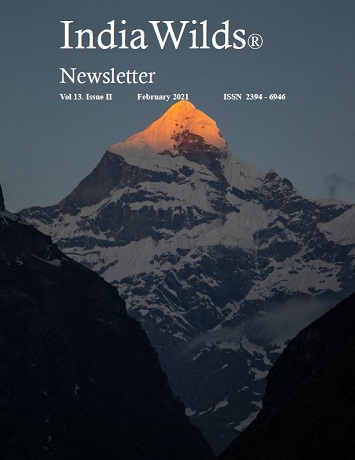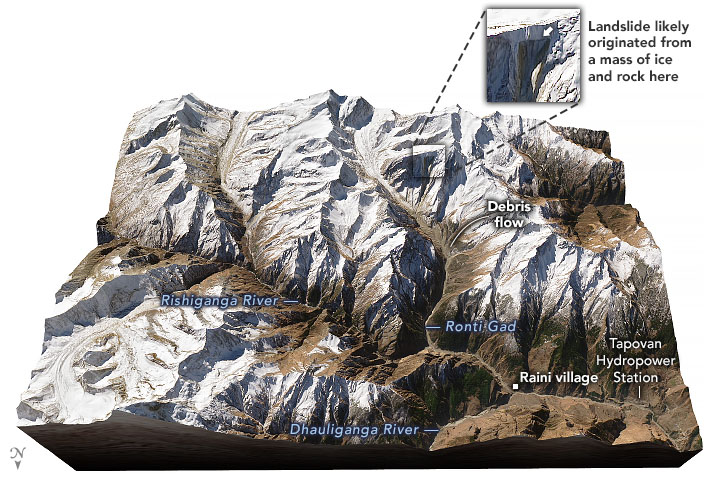IndiaWilds Newsletter Vol. 13 Issue II
ISSN 2394 – 6946
Wrath of Rudra: Again
द्यौ: शान्तिरन्तरिक्षं शान्ति:,
पृथ्वी शान्तिराप: शान्तिरोषधय: शान्ति:|
वनस्पतय: शान्तिर्विश्वे देवा: शान्तिर्ब्रह्मा शान्ति:,
सर्ब शांतिः, शान्तिरेव शान्ति:, सा मा शान्तिरेधि |
Meaning,
Let there be balance in the space, the sky, the earth! Let there be growth in the plants, in the trees! Let there be grace in God and bliss in the soul. Let there be balance in everything and let such peace be with every one of us! From this vedic message it is clear that environment belongs to all living beings, so it needs protection by all, and for the welfare of all.
The above message contains a quote from Yajur Veda and is from the opening part of India’s statement in the UN Security council open debate titled “Maintenance of international peace and security: Addressing climate-related risks to international peace and security.” It was read out by India’s minister for Environment, forests and climate change who also has the role of India’s heavy industry minister.
Yajurveda is estimated to have been written by 650 BCE. Vedas are not just religious text but also encompass truths that have influenced our culture and way of life for thousands of years. Since India’s environment minister has quoted this, it is expected that Indian Government will take actions to ensure that India’s environment will be protected for all living beings. Unfortunately, there is a big gulf between speaking wise words and practicing it.
India’s environment and wildlife are under unprecedented assault. There have been ill planned actions like industrial projects, dams, canals, thermal and hydel power projects, roads etc in ecologically fragile areas. This causes tremendous stress to the environment and these negative externalities are quickening and increasing the intensity and frequency of extreme weather events as our worlds is now facing a full-blown climate crisis. Unfortunately, we don’t seem to learn from our mistakes.
The Himalayan mountain range is a religious and cultural symbol that has deep meaning for Indians since time immemorial. However, from a geological perspective the Himalayas are comparatively younger than other mountain ranges. Scientists recon that Himalaya is still growing. The Himalaya has risen about 5000 feet since the middle Pleistocene. So Himalaya is structurally as well as ecologically fragile. Hence it is important that we calibrate our actions to ensure that there is no undue impact. Unfortunately, our policy makers are only focused on short-term financial gains and hence have allowed various dams and power projects in many of the tributaries of Ganga. Instead of doing an environment impact assessment of a project on an entire river basin, the authorities take a very narrow approach and look into a project on a standalone basis without looking at its impact on an overall ecosystem level. And the impact has been there to see for everyone.
In 2013 Uttarakhand faced massive landslides and tens of thousands of people, mules and domestic animals and villages were swept away. Now after 8 years, on 7th February 2021 water, ice, mud, rocks swept away all in its path in the Rishiganga river valley in Uttarakhand and hit two hydel power plants at Tapovan. First reports suggest that atleast 68 people died and 136 are missing. Many were trapped in the tunnel of the power project.
Though initial reports suggested that this landslide was due to a glacial lake bursting, subsequent analysis based on satellite images by Planet Labs suggested that a huge part of a hanging glacier broke and fell down freely for around a height of 2 km and the massive energy caused ice, rock as well as debris from digging by the power project to overwhelm the area.
There has been a lot of confusion in the past 24hrs surrounding the term 'glacier burst' and exactly what happened to cause the #UttarakhandDisaster flood. Analysis by myself and colleagues suggested a landslide that took out part of a hanging glacier. 1/n https://t.co/fWn6Qep9Me
— Dr Dan Shugar (@WaterSHEDLab) February 9, 2021
People of Reini village had filed a petition against the Rishiganga power projet at Tapovan in the high court in 2018. They had complained of drilling by the power project destabilizing the area. Even after the case the debris were not removed and locals complained that illegal drilling continued. Uttarakhand based environmentalist Ravi Chopra who heads the Supreme Court appointed Expert Body on Hydro-Electric projects and the High Powered Committee on the Char dham pariyojana has recently written to the Supreme Court that “Hundreds of crores spent in the last seven years for constructing these dangerous dams have ended up with the loss of over 200 persons, domestic animals and destruction of national property”. He further wrote “A section of the defense road to the Indo-China border and a bridge across the Rishiganga river on that road have been swept away, lending credence to our argument for disaster resilience in the region. Vulnerability and disaster proneness of this region is bound to increase with extensive disturbances like deforestation, slope cutting, blasting, tunneling, damming of rivers, excessive tourism, etc. The cumulative impact of such activities on the nearby glaciers cannot be ignored.”
The Government however was quick to dispute his views and attribute it to his own personal views and not that of the committee.
The Expert Body in its report submitted in April 2014 had written that HEPs (Hydro-electric projects) shouldn’t be constructed in the valleys north of the Main Central Thrust, a major geological fault where the Indian Plate has been pushed under the Eurasian Plate. Though MoEF&CC (Ministry of Environment Forests and Climate Change) had accepted the report, all the under-construction projects continued with their work. So there has been continuous impact on the geologically and ecologically fragile Himalayan landscape. Unfortunately the Government under the pretext of defense requirements and financial requirements of project proponents continues to ignore the ecological challenges. This has put the ecology and the wellbeing of the locals of the place under threat. These projects are touted as beneficial to the locals. However it is only the project proponents who benefit and the locals bear the brunt of the ecological impacts of these projects. And sadly we don’t learn from our past mistakes.
After the 2013 Uttarakhand landslide (Wrath of Rudra, June 2013, IndiaWilds Newsletter Vol. 5 Issue V https://www.indiawilds.com/diary/indiawilds-newsletter-vol-5-issue-vi/ ) we had written the peril of unplanned road building cutting the mountain vertically. So when water and mud during landslides fall down with vertically gathering huge energy and momentum. Instead having gentle slopes, planting trees and grass to stabilize the loose soil in the slope is the model followed internationally. However, in the Char Dham Pariyojana – the road bulding project which connects Badrinath, Kedarnath, Gangotri and Yamunotri – the project proponents have continued to construct roads in an ecologically destructive manner and dump the debris down the valleys. The Govermment has turned a blind eye to it. Infact, the Government has actively conspired to exploit the loopholes of the Environment Impact Assessment process by diving the Char Dham road building project into smaller components so that it can escape stringent provisions.
Whenever someone raises his/her voice against this, they are quickly branded as anti-national. Hence many people prefer to remain silent.
Himalaya is Holy. For thousands of years sages have meditated in these holy mountains. Some years ago a holy man said that when you mine and blast these holy mountains for profits you invoke the wrath of Rudra, the God of destruction. Even though our religion and culture teaches us to respect the nature and treat them as Gods, we are actively destroying nature. Hope these destructions wake up the Government from its slumber. Unfortunately, our Government doesn’t care scientific opinion as well as protests by holy men. Prof. G. D. Agarwal who had renounced and had later been known as Swami Sanand was fighting for the cause of Ganga and was conducting fast against dams in Ganga. Unfortunately, the Union Government refused to talk with him and he died on 11 October 2018 after fasting for 112 days. When a Government which talks about religion and culture doesn’t even listen to holy men as well as to scientific opinion to save the ecology of the Himalayan landscape, there doesn’t seem to be much hope.
If we don’t take actions now, it will be too late to do course correction as these projects are causing irreversible ecological damages to the Himalayas which will continue to impact us today and even our future generations. We the men and women of India Today will be accused by future generations for destroying this beautiful land, environment and forests and with it their lives and livelihoods.
Conservation News:
Ensure No parallel tracks for climate negotiations: India at UNSC
Representing India at the United Nations Security Council Open Debate on “Addressing climate-related risks to international peace and security”, Union Environment Minister, Shri Prakash Javadekar, stressed that the idea of climate action should not be to move the climate ambition goal post to 2050 and it is important for countries to fulfill their pre-2020 commitments.
Shri Javadekar said that the United Nations Framework Convention on Climate Change (UNFCCC) and the Paris Agreement negotiated under the Framework are the central mechanisms for climate action in a nationally determined manner based on certain fundamental agreed principles, the foremost amongst which is “Common but Differentiated Responsibility and Respective Capabilities”
Citing the 2019 IPCC Special Report “Climate Change and Land” which says that extreme weather and climate or slow-onset events may lead to increased displacement, disrupted food chains, threatened livelihoods, and could contribute to exacerbated stresses for conflict, Shri Javadekar put forward the point that even the best science available claims that Climate Change only exacerbates conflict and is not a reason for conflict and does not threaten peace and security and therefore it is important, said the Minister, to ensure that no parallel tracks for climate negotiations are created brushing aside the fundamentally agreed principles.
“While climate change does not directly or inherently cause violent conflict, its interaction with other social, political and economic factors can, nonetheless, exacerbate drivers of conflict and fragility and have negative impacts on peace, stability and security;and therefore it is for precisely this reason that developing country’s’ Nationally Determined Contributions under the Paris Agreement included information on adaptation activities, and the need for finance, technology development and transfer, capacity building, and transparency.”, said the Union Environment Minister.
Shri Javadekar again reiterated that the commitment by developed countries to jointly mobilize $100 billion per year by 2020 in support of climate action in developing countries has not been realized and also stated that there is an urgent need to promote and support the meaningful participation of women and marginalized groups in national-level climate change policy and planning processes.
On India’s Climate Actions Shri Javadekar stated that India is the only country on track among the G20 nations to meet its climate change mitigation commitments. We are not only meeting our Paris Agreement targets but will also exceed them. The Minister highlighted the International Solar Alliance (ISA) and the Coalition for Disaster Resilience Infrastructure (CDRI), the two initiatives by India that have been launched to addressing challenges of climate change and adaptation.
Commenting on post COVID-19 recovery, Shri Javadekar highlighted that India believes that there is a significant opportunity for countries to integrate low-carbon development in their COVID-19 rescue and recovery measures and long-term mitigation strategies that are scheduled to be announced for the reconvened 26th session of the Conference of the Parties (COP 26) in 2021.
The United Kingdom is holding the Presidency of the UNSC for the month of February 2021 and one of their Presidency events is organizing the United Nations Security Council Open Debate on “Addressing climate-related risks to international peace and security”.
Cleaner Fuel (PNG) Made Available to all identified industrial Units in Delhi
The newly formed Commission for Air Quality Management in National Capital Region and its Adjoining Areas took upon the switching over the industrial units in Delhi to cleaner fuels as one of the priority action item.
In this pursuit,1627 industrial units spread across 50 industrial areas in Delhi were identified to switch over to Piped Natural Gas (PNG). Periodic follow-up was conducted with M/s GAIL, IGL and Government of NCT of Delhi.
PNG has now been made available at the doorstep of all these 1627 identified industrial units and 1607 industrial units have already switched over to use of PNG in lieu of more polluting conventional approved fuels. The balance 20 industrial units, which are presently running on LPG, are also expected to be switched over to PNG by the end of February, 2021.
Delhi thus have all its industrial units operating on cleaner fuels. The impact of this move in terms of lowering the pollution load needs to be studied.
India’s first Centre for Wetland Conservation and Management Inaugurated
2nd Feb
India has nearly 4.6% of its land as wetlands, covering an area of 15.26 million hectares and has 42 sites designated as Wetlands of International Importance (Ramsar Sites), with a surface area of 1.08 million hectares. The year 2021 also commemorates the 50th anniversary of the signing of the Ramsar Convention on Wetlands on 2 February 1971 in Ramsar, Iran, celebrated annually as World Wetlands Day.
On the occasion of the World Wetland Day and as a part of its commitment towards conservation, restoration and management of India’s wetlands, the Minister of State for Environment, Forest and Climate Change, Sh. Babul Supriyo today announced the establishment of a Centre for Wetland Conservation and Management (CWCM), as a part of the National Centre for Sustainable Coastal Management(NCSCM), Chennai, an institution under the Ministry. The event was attended virtually by NCSCM, State Wetland Authorities and the knowledge partners of the Wetland Division.
Speaking at the launch the Minister of State for Environment highlighted the importance of wetlands in providing various ecosystem services. “The dedicated Centre which is launched today would address specific research needs and knowledge gaps and will aid in the application of integrated approaches for conservation, management and wise use of the wetlands.” said Shri Supriyo.
The Centre will help in building partnership and networks with relevant national and international agencies.WCM would serve as a knowledge hub and enable exchange between State/ UT Wetland Authorities, wetland users, managers, researchers, policy-makers and practitioners. The Centre would also assist the national and State/ UT Governments in the design and implementation of policy and regulatory frameworks, management planning, monitoring and targeted research for its conservation.
A publication on Faunal Diversity of all the Ramsar sites in the country and a brochure on Designation of Ramsar sites was also released to commemorate the occasion. The pdf of faunal diversity of Ramsar Wetlands can be downloaded from this link:
Equipment Discussions:
Sony Launches FX3 Full frame camera
Blackmagic Design announces new Blackmagic Pocket Cinema Camera 6K Pro
Rode Announces Wireless Go II
Natural History
COUNTRY NOTEBOOK: M. Krishnan: ‘The fretful Porpentine‘ shared By Saktipada Panigrahi
https://www.indiawilds.com/forums/showthread.php?8852-Country-notebook-m-krishnan&p=48527#post48527
Photography Tips – Learning Exposure
To make photography learning easier, we are creating a photography tutorial video series. The first part of photography tips is on learning exposure. Check it out in this link: https://youtu.be/PT3vvNIJx1g
Wildlife Photography
Leopard by Shyamala Kumar
https://www.indiawilds.com/forums/showthread.php?19836-Leopard-in-morning-haze
Tiger by Sabyasachi Patra
https://www.indiawilds.com/forums/showthread.php?19846-Tiger-in-clump-of-bamboo
Capped Langur by Samrat Sarkar
https://www.indiawilds.com/forums/showthread.php?19828-Capped-Langur-from-Manas
Gaurs by V S Sankar
https://www.indiawilds.com/forums/showthread.php?19824-Large-Herd-of-Gaurs!
Black-tailed Godwit by Mrudul Godbole
https://www.indiawilds.com/forums/showthread.php?19832-Black-tailed-Godwit
Coppersmith-barbet by Abhirup Dutta Gupta
https://www.indiawilds.com/forums/showthread.php?19838-Coppersmith-barbet
Rat Snakes by Samrat Sarkar
https://www.indiawilds.com/forums/showthread.php?19811-Territorial-combat-of-Rat-Snake
Praying Mantis by Arun Acharjee
https://www.indiawilds.com/forums/showthread.php?19812-Gold-bathed
Stink Bug by Prajwal Ullal
https://www.indiawilds.com/forums/showthread.php?19829-The-way-it-drinks
This is the 146 issue of IndiaWilds Newsletter. The early morning glow on the peak of Neelkanth peak in the Himalaya mountain range adorns the cover page of this issue.
We are in an era of Climate Change. Permafrost around the world is melting rapidly due to high global ambient temperatures. There are forest fires in Siberia which used to be known for its freezing temperatures. Scientists predict that due to melting of polar ice, a shipping route in the north pole could be possible in the next twenty years. The melting of ice in the poles is going to cause huge rise in sea levels. Due to these changes there would be lot of climatic catastrophes around the world. Earlier this month, a huge portion of a glacier fell down in Rishiganga river valley causing massive damage. It is time that we take stock of our actions and try to convince our elected representatives and Government that we as a Nation need to preserve our nature and environment for our own today as well as for our future generations.
I look forward to your inputs and support in preserving the last tracts of wilderness and wildlife left in our beautiful country and raising awareness about it. For other interesting articles and images check –
http://www.indi
To post in the IndiaWilds forums, you can register free of cost using your Full Name as user id at:
http://www.indiawilds.com/forums/register.php
If you are already a member of IndiaWilds and have forgotten your user id and/or password you can mail to:
administrator@indiawilds.com
Regards,
Sabyasachi Patra
Profile | Contact Us | Facebook | Diary | Equipment reviews | Forums | IndiaWilds You Tube Channel
Please post your views and feedback in the comments below.
- Endangered Wild Buffalo of Kaziranga - 4 July,2024
- Leopards: The Last Stand Trailer 2 - 1 July,2024
- GoPro Hero 12 Black - 6 September,2023










Leave a Reply